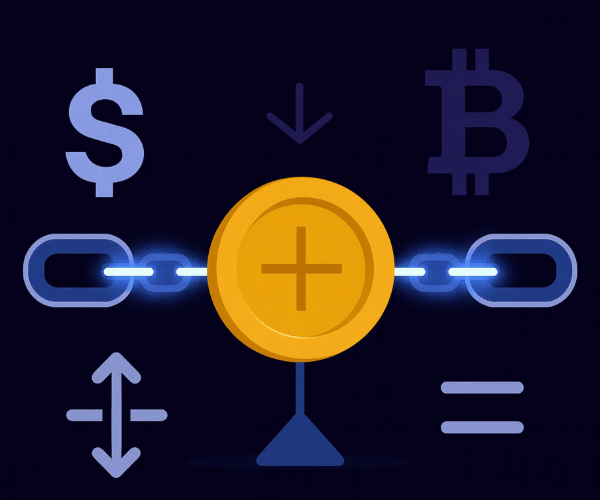Main > Blog > , You are here
The world of cryptocurrency is captivating with its possibilities, but its high volatility often deters newcomers. The prices of Bitcoin and other altcoins can soar and plummet by double-digit percentages in a single day. But what if there were a digital asset that combined the advantages of blockchain technology—speed, low fees, decentralization—with the stability of traditional money like the dollar or the euro? Such an asset exists, and its name is the stablecoin.
In this article, we will provide a detailed and accessible breakdown of what a stablecoin is in simple terms, how these amazing assets work, what types exist, and which stablecoin can be considered the most reliable. This is a complete guide that will help you understand why stablecoins have become a cornerstone of the modern crypto economy.
A Stablecoin is a Bridge Between Two Worlds
So, what is a stablecoin? To put it as simply as possible, a stablecoin is a cryptocurrency whose exchange rate is pegged to the value of another, stable asset. Most often, this asset is a fiat currency like the U.S. dollar, but it can also be the euro, gold, or even a basket of other cryptocurrencies.
Essentially, a stablecoin, in simple terms, is a digital analog of the money we're used to, living on the blockchain. It allows users to:
Store value without fearing sharp market fluctuations.
Transfer funds quickly and cheaply around the world without involving banks.
Trade on crypto exchanges, locking in profits in a stable asset.
The main goal of any stablecoin is to maintain a stable exchange rate at a 1:1 ratio with its underlying asset. For example, one USDT (Tether) stablecoin should always be worth approximately one U.S. dollar. This stability is achieved through various collateral mechanisms, which we will discuss below.

How Stablecoins Work: Mechanisms for Maintaining Stability
Stability isn't magic; it's the result of well-thought-out economic models. At the core of every stablecoin lies a fundamental mechanism known as the "peg"—rigidly maintaining its price at the level of the target asset, for example, $1. Imagine a stablecoin is a ship in the turbulent sea of the crypto market, and its collateral is the anchor that prevents it from drifting uncontrollably. However, not all anchors are equally reliable. The method by which a stablecoin "casts its anchor" and backs its value is its main characteristic and determines the level of trust in it. There are three main types of these "anchors," and understanding their differences is the key to assessing the safety and reliability of each specific stablecoin.
Fiat-Collateralized (Centralized) Stablecoins
This is the most popular and easiest type to understand. Each token of such a stablecoin is backed by real fiat money (or its equivalents, such as short-term government bonds) held in the bank accounts of the issuing company.
Example: The company Tether issues 1,000,000 USDT stablecoin tokens. To back their value, it must deposit $1,000,000 into its bank account. Users can at any time redeem their USDT tokens back for dollars, and the company is obligated to honor this exchange by burning the tokens.
This category includes the most well-known stablecoins:
USD Coin (USDC): Considered one of the most transparent and reliable, as its reserves are regularly audited.
Tether (USDT): The largest by market capitalization and the most widely used USD stablecoin.
Binance USD (BUSD): A product of the Binance exchange, also backed by the dollar.
These are the assets most often used for trading and savings, and the CoinsBar crypto exchange can offer you the ability to buy or sell them for fiat or another cryptocurrency. There are also stablecoins pegged to other currencies—for example, the euro stablecoin is becoming increasingly popular. A prime example is STASIS EURO (EURS), where each token is backed by one euro in the company's accounts. Such a stablecoin offers all the advantages of its dollar-backed counterparts but is geared towards users in the European jurisdiction.
Commodity-Collateralized Stablecoins
These operate on the same principle as fiat-collateralized ones, but the collateral used is not money but real physical commodities, most often precious metals.
The most prominent example is a gold-backed stablecoin. Tokens like Tether Gold (XAUT) or Paxos Gold (PAXG) are backed by real gold stored in secure bank vaults. One token usually represents ownership of one troy ounce or one gram of pure gold. This allows investors to invest in gold using the convenience and mobility of cryptocurrencies.
Algorithmic Stablecoins
This is the most complex and risky type. An algorithmic stablecoin is an asset that has no direct backing from real money or commodities. Its stability is maintained exclusively through complex algorithms and smart contracts.
How does it work? A smart contract automatically manages the supply of tokens on the market.
If the stablecoin's price falls below $1, the algorithm starts buying and burning tokens, reducing their quantity and thereby increasing the price.
If the price rises above $1, the algorithm issues new tokens, increasing the supply and lowering the price.
This often involves a two-token system: the stablecoin itself and a second, "governance" token that absorbs volatility. History has seen both successful and failed examples (like the collapse of TerraUSD), which proves the high risk of such a model.

Stablecoin List: Popular and Reliable Options
The market offers dozens of different stablecoins, but only a few have earned the trust of millions.
Here is a brief list of the market leaders:
Name: Tether
Ticker: USDT
Collateral Type: Fiat (USD)
Key Features: The most liquid and widespread, but with a history of questions regarding reserve transparency.
Name: USD Coin
Ticker: USDC
Collateral Type: Fiat (USD)
Key Features: High level of transparency, regular audits from leading firms.
Name: DAI
Ticker: DAI
Collateral Type: Crypto-Collateralized
Key Features: Fully decentralized, governed by the community through MakerDAO.
Name: STASIS EURO
Ticker: EURS
Collateral Type: Fiat (EUR)
Key Features: The leading stablecoin pegged to the euro.
Name: Paxos Gold
Ticker: PAXG
Collateral Type: Commodity (Gold)
Key Features: Regulated, each token can be redeemed for physical gold.
What is the Safest Stablecoin?
The question of safety concerns every investor. Although there are no 100% guarantees in the world of finance, several criteria can be used to determine reliability.
The safest stablecoin is one that:
Has full and transparent collateral: The issuing company must regularly publish reports from independent auditors confirming that each issued token is backed by a real asset at a 1:1 ratio. USDC is the leader by this criterion.
Has high liquidity: You must be confident that you can sell or exchange your stablecoin at any time without loss of value. USDT is the leader here.
Has a good reputation and is regulated: Projects that cooperate with financial regulators (like BUSD) inspire more trust.
Algorithmic stablecoins are considered the least safe due to the risk of a "death spiral," where the algorithm fails to cope with market pressure, and the token loses its peg.
The Role of Stablecoins in the Digital Economy
Stablecoins are an important tool in the world of digital currencies. They help manage volatility, making crypto assets more predictable and convenient to use. Such assets serve as a pillar for traders, a solution for international transfers, and an easy way to start working with cryptocurrency. Thanks to their peg to the dollar, euro, or gold, stablecoins have already taken their place in the financial system, linking traditional money with decentralized technologies.
